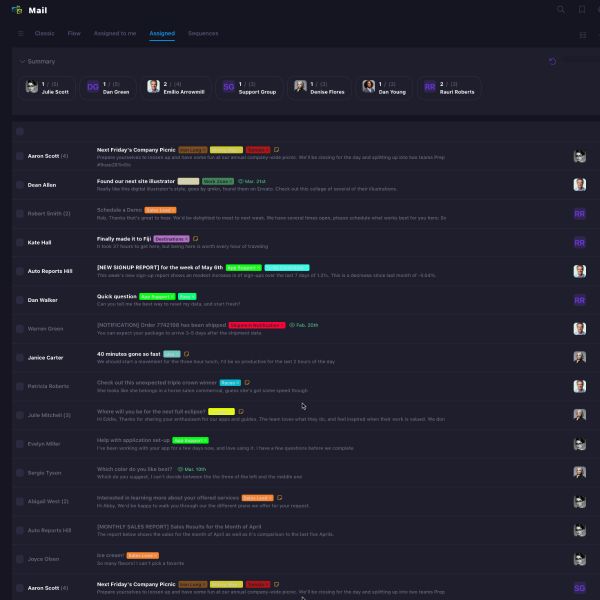
Every successful company is built on efficient teamwork, which in turn requires effective collaboration tools. If you're familiar with Google Workspace, you may have heard of Google Collaborative Inbox.
But does this Google feature have what it takes? Read our review of Google's Collaborative Inbox and decide for yourself. You'll learn what it is and discover its pros and cons. You'll also find that there's an even better solution, one that enhances collaboration at all levels.
What Is Google Collaborative Inbox in Google Groups?
Google Collaborative Inbox is a free inbox collaboration tool you can access by turning on Groups For Business.
Once set up, you can use it as a shared email folder and manage your team's incoming email conversations. All group members can now access and respond to conversations in the Collaborative Inbox.
How Does It Work?
Setting up a Collaborative Inbox is easy, but first, you'll need to create a Google Group. There's no way to use the Collaborative Inbox other than through Google Workspace's ‘Groups' feature.
From there, you'll enable the Collaborative Inbox feature and configure the settings of the group. This includes choosing the group's shared email address and setting permissions. Once you've completed the setup process, you can invite the team members to join the group.
The Pros of Google Collaborative Inbox
1. Free for Google Workspace Users
Google Workspace is the improved version of what used to be known as G Suite. It's a collection of communication, collaboration, and productivity apps in the Google products suite. Workspace users can access Google Collaborative Inbox for free but must set it up as described above.
2. Quick and Easy Setup
Like most Google products, this inbox tool is quick and easy to set up. There's no learning curve and no complicated setup procedures, which is always a plus in the time-sensitive business world. Your team will be using Google Collaborative Inbox in the next few days.
3. Different Permission Levels
Don't worry about unauthorized access to sensitive documents and files. Just set different permission levels as they are needed for safe and secure collaboration. It's easy to find this under the ‘settings' tab.
Assign your team members different permissions for access and control based on their roles.
4. Group and Label Conversations
Have you ever had to refer back to a conversation but were unsure where to find it? That's no longer a problem. Simply group and label your conversations to make it easy to retrieve them later.
Clicking on a label will direct you to settings to create a new label for a conversation. You can do this for single or multiple conversations.
The Cons of Google Collaborative Inbox
1. Doesn't Sync Emails Effectively
Your team members will jump between the two because Google Collaborative Inbox isn't integrated into Gmail. This will frustrate and delay your workforce.
With no effective email syncing and a confusing interface, this tool isn't as user-friendly and efficient as you may need it to be.
2. Risk of Duplicate Work
With teamwork, there's always the risk of duplication. Sending duplicate replies to a customer isn't just a waste of time; it creates an unfavorable impression of your organization. You'll appear out of touch with what's happening on your team. It can also lead to confusion and delays.
You should avoid duplicate work whenever possible. Although you can label conversations as complete, resolved, or duplicate, there's always the risk of duplicates. To avoid this, you'll have to pay careful attention to what's going on with your team.
3. No Reporting Tools
All the latest innovative apps and platforms offer data analytics and reporting. These aren't clever marketing gimmicks but essential tools for streamlining your processes.
Tracking email data like performance metrics and conversation trends can help you improve your service to your clients and customers. You'll know if your team is coping with its workload, and it can give you valuable insights into the volume of work that it handles daily.
With Google Collaborative Inbox, you cannot track any of these metrics. As your business scales, this problem will become increasingly detrimental.
4. Limited Features, Limited Growth
Google's products aim at a general market, with user-friendly features and easy access. This is what makes them so popular. However, Google Collaborative Inbox is surprisingly limited for a feature built around collaboration.
It doesn't offer simple yet crucial collaborative features like internal notes. Because it offers only basic collaborative functions, it's also not scalable. This is bad news if you plan to grow your business. You need collaboration tools that will grow with you.

How Helpmonks Can Help Your Inbox Better
You can enjoy the advantages of Google Group Collaborative Inbox but avoid the disadvantages by switching to Helpmonks!
Like Google Collaborative Inbox, Helpmonks' all-in-one email management platform offers a quick and easy setup. You can set different permission levels and group and label your conversations. Problems like the confusing interface fall away. It's also more suitable for collaboration.
Here are some features you'll enjoy with Helpmonks:
User-Friendly & Scalable
Helpmonks has an easy setup and a user-friendly interface that makes it a pleasure to use. You'll enjoy all the benefits of email management, communication, email marketing, customer engagement, etc.
Helpmonks is a scalable and multifaceted platform for all your team's collaborative needs. As a bonus, Helpmonks users can access our digital asset management platform, Razuna, for even greater value. The Helpmonks stack will continue facilitating collaboration and productivity as your company grows.
Shared Inboxes With Smart Rules
Every Helpmonks account includes a shared inbox; you can add as many team members as needed. You can assign and delegate incoming conversations with a simple click. You can also customize labels for individual or multiple conversations.
Or even better, let the inbox do all that for you. Smart rules apply, which means you can set the inbox to automatically assign the right emails to the relevant team members every time. It can also automatically add labels to emails that meet your set rules.
Collaboration Tools
Internal notes, attachments, and inline images make collaboration a breeze. And don't worry. Notes shared on internal emails are never shared outside the inbox. It's a discreet solution to dealing with any urgent issues that arise.
Every team needs a bit of outside help sometimes. Teams can often forget or overlook important tasks. Luckily, you won't have to worry about this with Helpmonks. Automated workflow rules alert your team to overdue replies and unanswered emails.
Analytics and Reporting
Unlike Google Collaborative Inbox, Helpmonks knows the value of analytics and reporting. So, we've included it as a feature in our email management platform. You'll stay up-to-date with your team's progress and gain deeper insights into how to improve your productivity.
No More Duplicates: Collision Detection
All Helpmonks plans include collision detection. This is guaranteed to prevent the hassle and embarrassment of duplicate replies. As soon as it detects two users replying to the same email, it sends an alert. Don't worry; you can turn this off if you wish.
Conclusion
Google Collaborative Inbox is easy to set up and use, but it lacks the features that large-scale collaboration requires. Luckily, the email management plans you'll find at Helpmonks tick all the boxes.
Get your team and organization started on the path to better collaboration and future growth. Give them the tools and the collaboration features that matter. You can do it right away when you register for a free trial!






